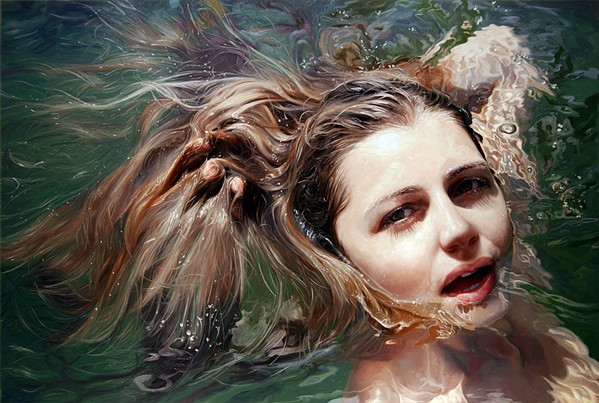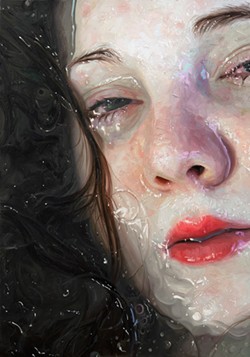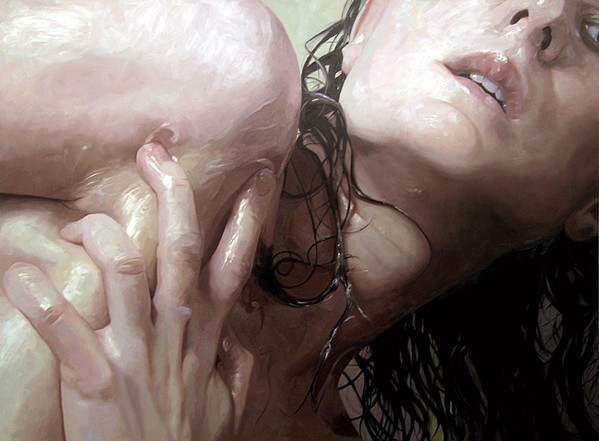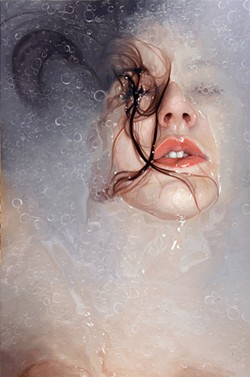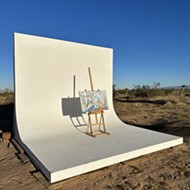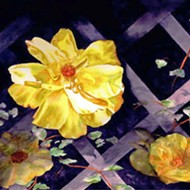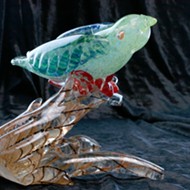Alyssa Monks' SLOMA retrospective features large-scale portraits of women in vulnerable, intimate contexts
By Glen Starkey[{
"name": "Newsletter Promo",
"id": "NewsletterPromo",
"class": "inlineCenter",
"insertPoint": "4",
"component": "15264767",
"requiredCountToDisplay": "0"
},{
"name": "Ad - Medium Rectangle CC01 - 300x250",
"id": "AdMediumRectangleCC01300x250",
"class": "inlineCenter",
"insertPoint": "8",
"component": "2963441",
"requiredCountToDisplay": "12"
},{
"name": "Ad - Medium Rectangle LC01 - 300x250",
"id": "AdMediumRectangleCC01300x250",
"class": "inlineCenter",
"insertPoint": "18",
"component": "2963441",
"requiredCountToDisplay": "22"
},{
"name": "Ad - Medium Rectangle LC09 - 300x250",
"id": "AdMediumRectangleLC09300x250",
"class": "inlineCenter",
"insertPoint": "28",
"component": "3252660",
"requiredCountToDisplay": "32"
}]
At a distance, Alyssa Monks' large-scale images look like photographs. Get closer, and soon it's clear that those shimmering surfaces, strands of hair, and luminous skin are created by brushstrokes and paint, which is why the Brooklyn artist makes a distinction between her work and photorealism.
"Photorealism is fastidious," she explained in an email interview. "It is detail focused, flat surfaced, and imitates a camera as closely as possible, intentionally removing the artist's hand completely.
"My aim is to do the opposite, ergo, my work is not actually 'photorealism,'" said Monks, whose work is on display at the San Luis Obispo Museum of Art in a retrospective titled Be Perfectly Still.
Instead, she's worked very hard at creating a surface that's painterly, wild, and full of happy accidents. Yes, she works from photographs. Water is often part of her images. Get near her paintings' surfaces and you'll see the work of a masterfully gifted painter who understands light and reflection in an astonishing way.
She sometimes mixes flour, oil, and other things into the water in which she submerges her subjects, which completely changes the surface in unusual ways, leading to new challenges in representing that surface. The results are remarkable.
"This selection of paintings touches on all the experiments I did with water over the years," she explained. "I loved trying new ways to make an image so that it would affect how I would paint it. I love that translation process, from flat image to painted surface and all the choices along the way.
"A photorealist copies a photograph and doesn't alter anything, edit anything, subtract anything. That was the opposite of what I was interested in," she said. "Experimenting with different elements and filters allowed me to think more about paint and how it behaves (and misbehaves) as the images got more abstract and more sensual."
Photorealist painters often favor inanimate objects—architecture, machines, toys. Few attempt figurative subjects. Why is Monks drawn to (mostly) female faces and forms?
"I paint what I know about. I am a woman, so I paint women mostly."
Where do her titles come from?
"Bait is a little bit about the male gaze," she explained. "To me, the painting looked like a young, pretty girl seducing the viewer at first, drawing him in. And there is something lurking in the water, something in her hair, her hand, or maybe not. So like bait—it's drawing you in to something you don't yet know is actually quite dark.
"Be Perfectly Still is about not struggling in the face of uncontrollable and painful circumstances," she continued. "It's part of the last show I did called 'It's all under control,' titled tongue and cheek because it clearly is not all under control.
"Vaseline II is titled Vaseline II because I made a painting called Vaseline, and upon my experimentation with Vaseline, which I loved working with at the time, I did not want people to mistaken the substance for anything else. But maybe also I did.
"Charade is pointing to the whole bait and switch of art-making in general. As Picasso said, and I am misquoting, but, 'Art is a lie through which the truth is told.' Also, she looks like she could be drowning or suffering or gasping for air, but only because it's a painting. A photograph would raise much less alarm because we know it's a fraction of a second. A painting feels longer and more sustained. It feels frozen in time."
Monks explained a major turning point in her art and life during a 2015 TED Talk when she revealed what it was like to lose her mother to cancer a few years earlier. Deeply moving, the talk expressed what a transformative experience it was.
"Witnessing my mother's decline and death truly broke me down and made me understand we (I) have much less control over anything than I realize. And there was a whole world of amazing interactions, inspirations, connections, moments that we (I) can make myself available for when I put down the controls and allow it all in.
"In my mind, I quit painting. And then I started over with all this in mind. Eventually, I integrated the two minds—I like to refer to them as Apollonian and Dionysian—the former being systematic, linear, logical, and predictable; the latter being intuitive, emotional, abstract, unpredictable, spontaneous, and nonlinear. I didn't feel a need to paint what a camera or an eye saw as 'reality.' Instead, I was curious to create a world that expressed a psychic reality."
Don't miss seeing these paintings up close and in person—they're deeply affecting.
"What you're looking at is a woman trying to tell her story but never really showing herself fully," Monks said. "The tension is all about who the world wanted her to be versus who she is, and she doesn't yet know who that is exactly. She is daring herself in each painting to reveal a little more and pulling back a veil of obfuscation for protection. In other words, the work is autobiographical, pages from a diary without words, not sure how much is OK to say.
"And these 13 pieces are only a small sample of the 300 or so works out there over the last 20-plus years." Δ
Contact Senior Staff Writer Glen Starkey at [email protected].

